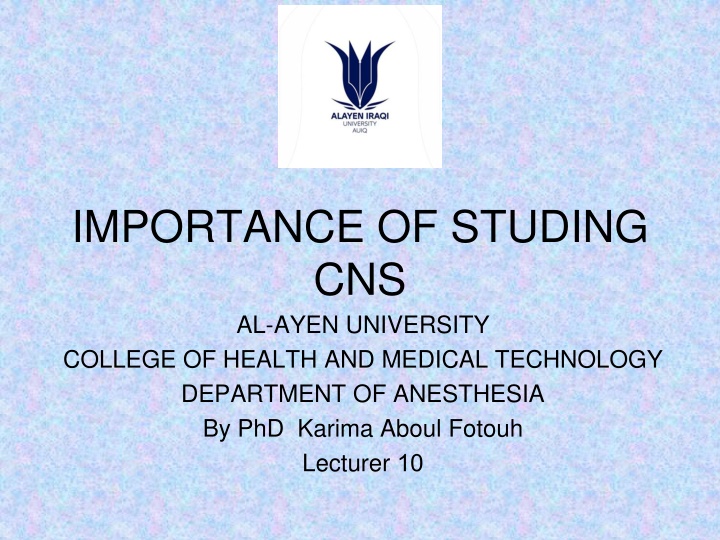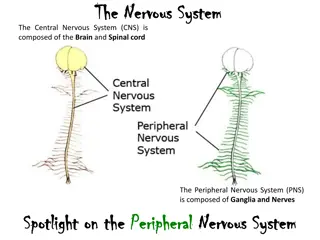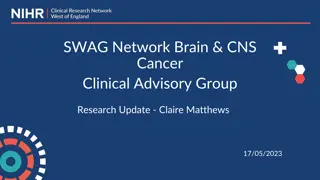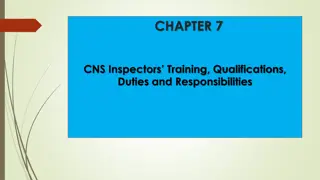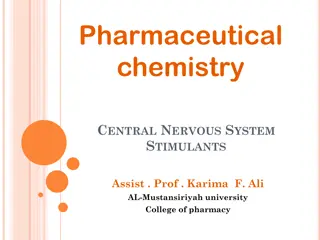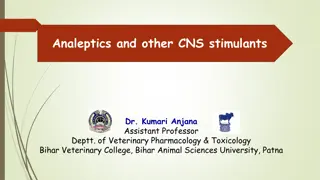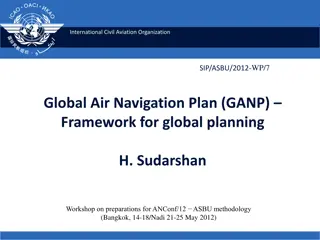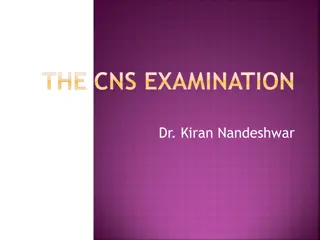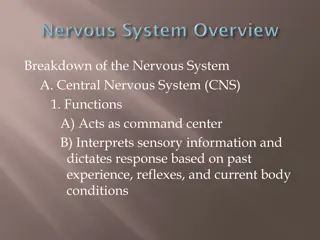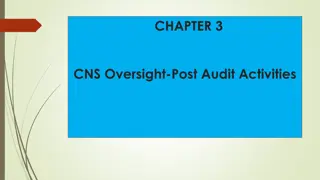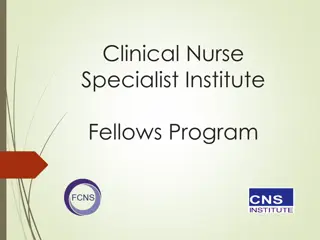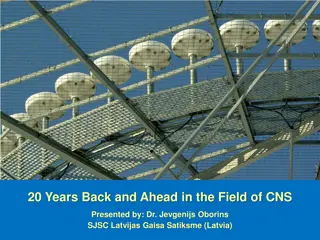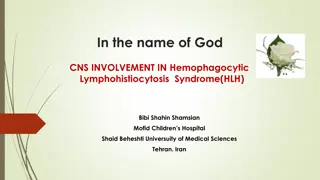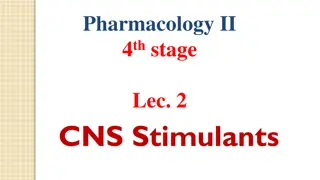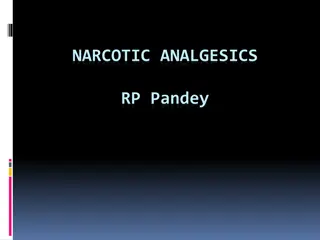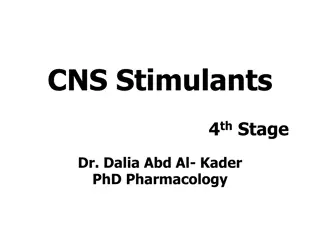Significance of CNS Study at Al-Ayen University College of Health
Drugs acting on the central nervous system are widely used, with potential for tolerance and dependence. Understanding the CNS mechanism, neurotransmission, and important parts like cortex, basal ganglia, and limbic system are crucial. Major differences between CNS and autonomic nervous system involve complexity, synapse quantity, inhibitory neurons, and diverse neurotransmitters. Study of the CNS is essential for comprehending brain function and controlling body processes.
Download Presentation

Please find below an Image/Link to download the presentation.
The content on the website is provided AS IS for your information and personal use only. It may not be sold, licensed, or shared on other websites without obtaining consent from the author.If you encounter any issues during the download, it is possible that the publisher has removed the file from their server.
You are allowed to download the files provided on this website for personal or commercial use, subject to the condition that they are used lawfully. All files are the property of their respective owners.
The content on the website is provided AS IS for your information and personal use only. It may not be sold, licensed, or shared on other websites without obtaining consent from the author.
E N D
Presentation Transcript
IMPORTANCE OF STUDING CNS AL-AYEN UNIVERSITY COLLEGE OF HEALTH AND MEDICAL TECHNOLOGY DEPARTMENT OF ANESTHESIA By PhD Karima Aboul Fotouh Lecturer 10
IMPORTANCE OF STUDING CNS Drugs acting on the central nervous system (psychotropic drugs) are more used than any other type of medicaments. CNS-acting drugs are also socially used without medical advice ( caffeine, nicotine, alcohol, cannabis, opiates, amphetamines ) Most central drugs produce tolerance , psychological and/or physical dependence with long-term use The brain plays a central role in control of most body functions ( awareness, movements, sensations, thoughts, memory ) Some reflex movements can occur via spinal cord The spinal cord is connected to the brain stem and runs through the spinal canal The spinal cord carries signals (messages) back and forth between the brain and the peripheral nerves
Mechanism of Impulse in CNs Nerve Cell ( neuron ) Nerve Cell ( neuron ) Connection Connection Resting Potential Resting Potential Mechanism of Impulse in CNS Voltage operated channels ( Na , CL , K , Ca ) Receptor operated channels NEUROTRANSMISSION IN THE CNS NEUROTRANSMISSION IN THE CNS Arrival of nerve action potential Ca diffuses into the presynaptic membrane leading to the release of neurotransmitters Neurotransmitters bind to specific receptors on the postsynaptic neuron resulting in either EPSP(Na influx) or IPSP(Cl influx) Binding triggers intracellular changes
THE MOST IMPORTANT THE MOST IMPORTANT PARTS OF CNS PARTS OF CNS Cortex Cortex Basal ganglia ( Basal ganglia ( straitum Reticular activating system ( RAS ) Reticular activating system ( RAS ) Limbic system ( LS ). Limbic system ( LS ). Hypothalamus Hypothalamus Thalamus Thalamus Medulla. Medulla. Mid brain Mid brain Cerebellum Cerebellum Medial forebrain bundles ( MFB ) Medial forebrain bundles ( MFB ) Periventricular system ( PVS ) Periventricular system ( PVS ) straitum ) )
Major differences between neurons in the peripheral autonomic nervous system and CNS CNS is much more complex than the autonomic nervous system Number of synapses in the CNS is far greater CNS contains networks of inhibitory neurons (GABA) modulate the rate of neuronal transmission CNS communicates through many neuro transrnitters ( NE , Glutamate , Aspartate, Gama amino butyric acid GABA , glycine , Dopamine , Serotonin , neuropeptides )
CENTRAL NEUROTRANSMITTERS Amino Acids Excitatory L-glutamate L aspartate Inhibitory GABA Glycine Amines ( DA , NE , 5-HT ) DA : Dopamine NE : Nor-epinephrine 5-HT : Serotonin Acetyl Choline ( Ach ) M1 : Excitatory M2 : Inhibitory N : Excitatory Peptides Histamine Purine
Antipsychotic Drugs (Major tranquillizers Neuroleptics ) & Lithium The terms antipsychotic and neuroleptic drugs are used mainly for treating schizophrenia but are also effective in some other psychoses and agitated states. Psychosis is thought to be due to overactivity of dopaminergic pathway in limbic system so treatment aims at blocking of these receptors or decreasing dopamine . 5HT may also have a role . Classification of antipsychotic drugs Typical (DA antagonists) 1) Phenothiazines : Chlorpromazine Thioridazine Trifluperazine 2)Butyrophenones Haloperidol Atypical (5-HT/DA antagonists) Risperidone Clozapine Olanzepine
Chlorpromzine Pharmacokinetics : Absorbed orally, metabolized in liver, excreted in urine . Actions : 1.C.N.S. : Antipsychotic action by blocking dopaminergic receptors in limbic system (D2) . Antiemetic action by inhibiting dopaminergic receptors (D2) in C.T.Z. so not effective motion sickness . Hypothermic action though increasing heat loss ( by V.D. induced by V.M.C., heat regulating center, -blocker and direct action ) and inhibition of shivering ( compensatory heat production ) . Sedation and augment other C.N.S. depressants . Large doses produce parkinsonism due to dopaminergic receptor block in basal ganglia (D2) .
2) C.V.S. : Hypotension due to direct V.D., -blocking effect, direct cardiac depression and inhibition of central pressor reflexes . Tachycardia due to hypotension ( reflex ) and atropine like action . Inhibits uptake of noradrenaline . Negative inotropic action and quinidine like action on heart . 3) It blocks , H1,, 5HT2 and M receptors (atropine like-action ). 4) Local anaesthetic action, membrane stabilizing action . 5) prolactin due to block of dopaminergic receptors in hypothalamus so decrease prolactin inhibitory releasing factor ( D2effect ) amenorrhea, galactorrhea, infertility and impotence .
Uses : 1. 2. 3. 4. Antipruritic . Adverse effects : Cholestatic jaundice. Acute dystonia . Parkinsonism . Akathisia ( motor restlessness ). Postural hypotension . Tardive dyskinesia ( oral-facial dyskinesia ) on long use . Allergic reaction : blood dyscrasias, dermatitis, corneal and skin deposits and photosensitivity . Weight gain . Amenorrhea, galactorrhea, prolactin, infertility, loss of libido and impotence . Psychiatric disorders ( schizophrenia-agitation, mania) . Antiemetic in small dose ( not in motion sickness ) . Preanaesthetic medication . To produce hypothermia .
Butyrophenones Related to phenothiazines and include droperidol and haloperidol . Act by blocking dopaminergic receptors and have mild hypotensive effect . Lithium carbonate ( Antimanic mood stabilizing agent ) Mechanism : Not clear, but may affect the release of noradrenaline, 5HT, dopamine . Uses : It is used mainly for prevention of bipolar manic depression ( it is a disorder characterized by attacks of depression alternating with attacks of mania. increased catecholamine activity has been shown to be associated with mania).
Adverse effects : Anorexia, vomiting, diarrhea. Antagonizes ADH: polyuria thirst, nephrogenic diabetes insipidus. Hypotension, cardiac arrhmias, Thyroid enlargement. Epileptic seizures and confusion . Teratogenic in eary pregnancy . Cumulative (thiazide and loop diuretics decrease lithium clearance) . Toxicity is treated by osmotic diuretics and I.V. sodium bicarbnate and dialysis in severe poisoning .
Antidepressants Drugs Drugs for disorders of mood Depression may be associated with low levels of noradrenaline and / or serotonin at certain site in brain . So treatment aims at increasing the level of these biogenic amines by : 1. Inhibition of their uptake in nerve terminals by tricyclic, heterocyclic antidepressant and selective serotonin reuptake inhibitors ( SSRI s ) . 2. Inhibition of their destruction by MAO inhibitors .
A) First generation : Tricyclic antidepressants ( TCAs ) 1- Imipramine and its major metabolite desipramine . 2- Amitriptyline and its metabolite nortriptyline . They are related chemically to phenothiazines so have antimuscarinic, antihistaminic and -blocking effect with very little effect on dopamine transport . Mode of action: By cocaine like action they prevent uptake I of noradrenaline, and serotonin. Down-regulation of presynaptic inhibitory receptors lead to increase in neurotransmiiter Pharmacokinetics: Absorbed orally Actions: C.N.S.: - Antidepressant effect in depressed patients (slow onset for weeks), while in non-depressed patients sleepiness may occur. - Block , muscarinic , serotonin and histamine receptors, but do not inhibit MAO. C.V.S.: - Postural hypotension and arrhythmia. .
Uses: 1-Depression and panic anxiety disorders. 2-Nocturnal enuresis. 3-Chronic pain, neuralgia and migraine headache. Side effects: Atropine like action: blurred visions, dry mouth, urine retention, constipation. blockade: tachycardia, palpitation, postural hypotension and weight gain. H1blockade: sedation, fatigue. Cardiotoxicity: conduction block and arrhythmia. Sexual dysfunction. Overdose produces cardiac toxicity, convulsion , coma and suicide Contraindications: Glaucoma (narrow angle), prostatic hypertrophy, epilepsy, liver and kidney diseases.
B) Second generation : Bupropion inhibit NE and DA uptake, useful as antidepressant and smoking cessation. Advantage over TCAs: No autonomic side effects No atropine like action No sedation No postural hypotention No cardiotoxicity No weight gain Safer in overdose No sexual disfunction
C) Third generation : Venlafaxine is a potent inhibitor of 5HT reuptake and weaker for norepinephrine.at high dose HR and BP. Advantage over TCAs: No autonomic side effects No atropine like action No sedation No postural hypotention
Selective serotonin reuptake inhibitors (SSRIs) Fluoxetine: They block 5HT uptake with no effect on noradrenaline uptake . Used in depression, anxiety states ( panic, phobias) , bulimia and alcoholism Side effects : nausea, decreased libido, sexual disfunction, weight loss. Interactions : With MAOIs serotonin syndrome is induced ( hyperthermia, muscle rigidity and rapid changes in mental condition ) Advantage over TCAs: No autonomic side effects No atropine like action No sedation No postural hypotention No cardiotoxicity No weight gain Safer in overdose
Monoamine oxidase inhibitors ( MAOIs ) MAO is present in CNS, adrenergic nerve terminals, liver, gut and platelets . MAO-A resposible with metabolism of natural catecholamines, serotonin, tyramine . Classification : Nonselective: Phenelzine, tranylcypromine. They act by irreversible non competitive mechanism . Selective: Moclobemide (MAO-A inhibitor) Selegiline (MAO-B inhibitor)
Pharmacokinetics : Given orally Actions : Elevation of mood by increasing the level of 5-HT and catecholamines in brain . The effect appears after few weeks . Some of them release noradrenaline as tranylcypromine . Uses : Psychogenic depression . MAO Adverse effects : Tremors, insomnia, confusion, convulsions. Postural hypotension- atropine like action weight gain Hypertensive crisis if patient eats food containing tyramine . Overdose caused delirium, consciousness, seizures, shock and hyperthermia. -B inhibitor in parkinsoism .
Interactions : With food containing tyarmine (as cheese and youghourt ) hypertensive crisis occurs( treated by -blocker as phentolamine ) . Potentiate the effect of sympathomimetics hypertensive crisis . With tricyclic antidepressants hypertension . Reverse the hypotensive effect of reserpine . Interfere with action of guanethidine . with selective serotonin reuptake inhibitors (SSRIs) Serotonin syndrome .
Local anaesthesia They reversibly block impulse conduction in nerves. Classifications : Esters of benzoic acid : cocaine (natural) . Esters of Para amino benzoic acid : Procaine, benzocaine . Amides: Lidocaine, dibucine, mepivacaine and ropivacaine . Procaine, lidocaine, are soluble and are given by injection or used locally except procaine ( not for surface anaesthesia ) . Cocaine is used topically on eye and are soluble . Benzocaine is insoluble and is used only on skin . Fate : Esters are hydrolyzed by pseudocholinesterase so they have short duration, while amides are degraded by liver microsomal enzymes .
Mechanism of action : Blockade of voltage-gated sodium channels. Local anaesthetics cause reversible interruption of the conduction of impulses in peripheral nerves. The primary electrophysiological effect of these compounds is to cause a local decrease in the rate and degree of depolarization of the nerve membrane There is no effect on the resting or threshold potential, although the refractory period and repolarization may be prolonged. These effects are due to blockade of sodium channels, thereby impairing sodium ion flux, across the membrane.
Factors affecting action of local anaesthetics : PH :increased PH will increase the action due to the non-ionized form, while decreased PH will decrease their action. Elevated extracellular Ca2+antagonizes their action, while elevated K + enhances their effect. Vasoconstrictors as adrenaline prolong the duration . Actions : Block impulse conduction in sensory nerves, ganglia, nerve trunk and neuromuscular junction . Vasodilatation of blood vessels (except cocaine which is V.C. due to block off uptake-1 of noradenaline) . So vasoconstrictors are added with them to prolong their duration . Depression of heart (quinidine like action) except cocaine . C.N.S. stimulation anxiety, tremors, convulsions followed by R.C. depression . So give diazepam before . Spasmolytic action on smooth muscles .
Toxicity of local anaesthesia : A-systemic : C.N.S. stimulation then depression. Shock, vasovagal attack and quinidine like action on heart. Allergic reactions (more with PABA esters). Methaemoglobinemia (with prilocaine). B- Local : Persistant parasethesia or anaesthesia, oedema, hematoma, pain at site of injection and facial nerve paralysis.
Complications of spinal anaesthesia : 1. Hypotension due to arteriolar and venous dilatation . 2. Headache . 3. Respiratory paralysis . 4. Septic meningitis due to bacterial contamination. Hypotension is prevented by ephedrine or methoxamine and is treated by elevation of legs, intravenous fluids and noradrenaline drip . Contraindications : Advanced liver disease . Hypertension, heart disease and thyrotoxicosis (don t give adrenaline with local anaesthetic) .
Methods of administration : 1. Surface anaesthesia : direct application on membrane . 2. Infiltration anaesthesia : injection directly into the tissue to reach fine nerve branches . 3. Nerve block anaesthesia : injection close to nerve trunk . 4. Caudal anaesthesia : injection in sacral canal . 5. Spinal anaesthesia : injection in lumbar region . 6. Epidural anaesthesia : injection outside the dura between dura and bony spinal canal . It is less liable to produce hypotension .
